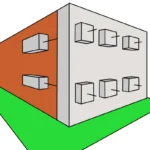Non-Mechanical Properties of Materials
In the realm of civil engineering, where the creation of structures goes hand in hand with safety and functionality, material properties take on an undeniable significance. While mechanical properties are unavoidable to ensure structural strength, non-mechanical properties should not be underestimated. They add an additional dimension of consideration and complexity to the selection, use, and behavior of materials. In this context, three properties particularly capture the attention of civil engineers: density, thermal properties, and surface characteristics. But we won’t stop there; we will also explore other non-mechanical properties that, in their own way, play a crucial role in civil engineering.
Non-mechanical properties of materials refer to intrinsic qualities that do not have a direct relationship with a material’s response to mechanical loads, such as force or deformation. These properties encompass aspects like thermal conductivity, corrosion resistance, permeability, electrical and magnetic capabilities, among others. In civil engineering, understanding and considering these properties are fundamental, as they impact the durability, performance, and lifespan of structures and components. For example, when choosing materials for bridges, buildings, or infrastructure, it is imperative to evaluate their corrosion resistance in specific environments, their ability to transmit heat in HVAC systems, or their suitability for electrical insulation in electrical installations. Considering these non-mechanical properties ensures that engineering solutions are safe, efficient, and sustainable over time.

Density and Specific Weight:
The density of a material is the ratio of its mass to its volume. In the vast domain of civil engineering, density stands as an essential attribute that directly impacts the load a structure can bear. A structure’s ability to resist external forces is intrinsically linked to the density of the material used in its construction. Engineers must carefully weigh this property when choosing materials, as high density can result in a greater structural load, but it can also increase the overall weight of the structure, affecting the project’s economy and logistics.
Density, defined as the mass per unit volume of a material, and specific weight, understood as the weight per unit volume (usually in N/m^3 or lb/ft^3), take on a crucial dimension in civil engineering by enabling the calculation of loads and stresses induced by the weight of structures and materials themselves. Choosing materials with appropriate densities has the potential to reduce structural load and, consequently, the size of construction elements. Additionally, in asphalt and concrete mixtures, the relationship between the weight and volume of aggregates and binders is essential for achieving optimal proportions in the mix.
Common cases: When designing bridges, buildings, or other structures, considering the weight of materials becomes fundamental to ensuring stability and safety. In the design of concrete or asphalt pavements, the proportion of aggregates in the mix is based on the relationship between the weight and volume of the components.
Recommendation for engineering students: It is essential for civil engineering students to become familiar with the physical properties of materials and understand how these qualities influence the behavior of structures. Learning to calculate and analyze loads derived from the weight of materials will assist future engineers in making informed decisions about material selection and designing efficient structures.

Thermal Expansion:
The thermal properties of materials have a significant impact on the behavior of structures in extreme heat and cold conditions. Civil engineers must understand how materials expand and contract in response to temperature fluctuations, as this can affect the stability and durability of structures over time. Furthermore, thermal properties also play a crucial role in the design of insulation and HVAC systems, influencing the energy efficiency of buildings and the comfort of occupants.
Thermal expansion refers to the change in length or volume of a material due to temperature changes. Almost all materials expand with increasing temperature and contract when the temperature decreases. This property is crucial in the design of structures composed of materials with different coefficients of thermal expansion. Differences in thermal expansion can cause deformations and stresses in the structure.
Common cases: In climates with extreme temperature variations, such as winter ice formation and high summer temperatures, materials in structures may experience stress due to thermal expansion differences. Expansion joints in buildings, bridges, and pavements are used to allow for expansion and contraction without causing damage.
Recommendation: Students should acquire a deep understanding of the effects of thermal expansion on structures and learn to apply design strategies that minimize associated risks. Familiarizing themselves with the coefficients of thermal expansion of different materials and understanding how they affect the interaction between structure components is crucial for developing safe and durable solutions.
Surface Characteristics:
The surface characteristics of materials are crucial in the interaction between the structure and its environment. Surface roughness, porosity, and wear resistance are key properties that affect the durability and stability of structures in various environmental conditions. Choosing materials with appropriate surface characteristics can prevent corrosion, improve the adhesion of protective coatings, and optimize the aesthetic appearance of structures, especially in urban and publicly exposed environments.
Surface properties, such as corrosion and degradation resistance, the ability to withstand abrasion and wear, and surface texture, are vital to ensuring the durability and performance of structures over time.
Common cases: Metal corrosion in structures exposed to humid or corrosive environments can weaken the structure’s integrity. Wear resistance is essential in pavements and elements subjected to repetitive loads, such as roads and bridges. Proper surface texture in pavements helps provide friction and prevent vehicle slippage.
Recommendation: Students should acquire in-depth knowledge of corrosion, degradation, and wear processes, as well as prevention and mitigation strategies. Learning about different coatings and treatments that can protect materials from environmental exposure is essential for making informed decisions during design and construction. Additionally, understanding how surface texture influences friction and surface behavior will allow students to design safer and more functional pavements and structures.

Other Important Non-Mechanical Properties:
In addition to the mentioned properties, there are other non-mechanical properties that also play an essential role in civil engineering:
Thermal Conductivity: A material’s ability to conduct heat is crucial in the design of heating, ventilation, and air conditioning systems, as well as in preventing issues like ice accumulation in structures exposed to low temperatures.
Moisture Absorption: A material’s ability to absorb and release moisture can affect dimensional stability and resistance to degradation in humid environments. This property is particularly relevant in regions with high atmospheric humidity or in structures near bodies of water.
Electrical Conductivity: In applications where electrical conduction is essential, such as in transportation infrastructures and communication systems, the electrical conductivity of materials becomes crucial to ensure reliable and safe performance.
Chemical Reactivity: Some environments may expose materials to corrosive or reactive chemicals. The chemical resistance of materials is essential to prevent premature degradation and maintain the integrity of structures over time.
Electromagnetic Transparency: In projects involving wireless technologies, such as antennas and communication systems, the ability of materials to transmit electromagnetic signals without interference is a critical property.
Conclusion
Although delving into these material properties may seem like a superfluous exercise, their importance in the realm of civil engineering is undeniable. Even when materials are predetermined in common scenarios, and educators provide solid guidelines, we must remember that our trajectory is not limited to the conventional. Who knows in what realm of civil engineering, and even beyond, we might find ourselves in the near future. The time will come when we have to merge our creativity and wisdom to discern the ideal material for a unique project or one suitable for particular environmental conditions.
We should never assume anything as a foregone conclusion. Confidence in our work is grounded in a deep understanding of the scientific fundamentals that adorn our profession.
The civil engineer is not just a manipulator of plans and designs but also a solver of mysteries and a pioneer. Engaging with the non-mechanical properties of materials, even though it may seem intricate, gives us the opportunity to unleash our creativity and apply our scientific understanding in unique contexts. Every structure we build, every bridge we conceive, and every infrastructure we create has its own demands and unique attributes. Being armed with a solid understanding of the non-mechanical properties of materials positions us where we can face challenges with certainty and originality. While we may start from a foundation, we should not shy away from exploration beyond, because it is in that uncharted space where civil engineers demonstrate their worth, adaptability, and resolve to build a more stable and sustainable world.
About The Author
Samuel Parariá
Estudio: University of Francisco de Paula Santander.
Major: Civil Engineering.
Favorite Areas: Structures, Traffic Engineering, and Road Design.
Location: Cúcuta, Norte de Santander, Colombia.







Related
Pavers in Civil Engineering
Mechanical Properties of Materials (under construction)
Ecological Bricks: The Future of Sustainable Construction